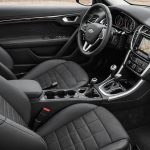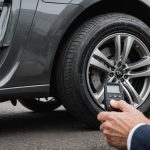Mastering Tire Pressure Monitoring Calibration: Essential Tips for UK Driving Conditions
Understanding the Importance of Tire Pressure
When it comes to maintaining your vehicle, one of the most overlooked yet crucial aspects is tire pressure. Properly calibrated tire pressure can significantly impact your car’s performance, safety, and fuel efficiency. In the UK, where driving conditions can be quite varied, ensuring the right tire pressure is more important than ever.
“Tire pressure is often the last thing on people’s minds, but it’s one of the first things you should check,” says John Smith, a veteran mechanic. “Incorrect tire pressure can lead to reduced handling, increased fuel consumption, and even safety hazards.”
Topic to read : Essential Tips for Properly Installing Your Vehicle”s Heat Shield to Avoid Overheating
Here are some key reasons why tire pressure matters:
- Safety: Underinflated tires can lead to reduced traction, which increases the risk of accidents, especially on wet or icy roads.
- Performance: Proper tire pressure ensures better vehicle handling and stability.
- Fuel Efficiency: Correctly inflated tires can improve fuel efficiency, saving you money on petrol.
- Tire Life: Underinflated tires wear out faster, requiring more frequent replacements.
How to Check Tire Pressure
Checking tire pressure is a straightforward process, but it requires the right tools and a bit of knowledge.
Also read : Essential Tips for Maintaining Your Vehicle”s Heated Seats: Boost Driver Comfort and Safety
Tools You Need
- A reliable tire pressure gauge
- Your vehicle’s owner’s manual
- The tire information placard (usually found on the driver’s side doorjamb or inside the fuel filler door)
Steps to Check Tire Pressure
- Ensure the Tires are Cold: Tire pressure should be checked when the tires are cold, meaning the vehicle has not been driven for at least three hours.
- Locate the Recommended Pressure: Check your owner’s manual or the tire information placard for the recommended tire pressure.
- Remove the Valve Cap: Take off the valve cap to expose the valve stem.
- Attach the Gauge: Press the tire pressure gauge onto the valve stem and hold it firmly until it is stable.
- Take the Reading: The gauge will show the current pressure. Compare it to the recommended pressure.
- Adjust as Necessary: If the pressure is too low, add air. If it’s too high, release air.
Types of Tire Pressure Gauges
There are several types of tire pressure gauges available, each with its own advantages.
Digital Gauges
- Accuracy: Digital gauges are highly accurate and easy to read.
- Ease of Use: They often have backlighting and automatic shut-off features.
- Example: The Michelin Digital Tire Pressure Gauge is a popular choice among drivers.
Analog Gauges
- Reliability: Analog gauges, such as those using a bourdon tube, are reliable and less prone to battery issues.
- Cost-Effective: They are generally cheaper than digital gauges.
- Example: The Slime Analog Tire Pressure Gauge is a simple yet effective option.
Stick Gauges
- Portability: Stick gauges are compact and easy to carry.
- Ease of Use: They are simple to use but may not be as accurate as digital or analog gauges.
- Example: The Accu-Gage Stick Tire Pressure Gauge is a handy tool for quick checks.
Calibration Tips for UK Driving Conditions
UK driving conditions can be quite diverse, from urban roads to rural highways, and even motorways. Here are some tips to ensure your tire pressure is calibrated for these varying conditions:
Urban Driving
- Lower Speeds: For city driving, slightly lower tire pressures can improve comfort and handling.
- Example: If the recommended pressure is 35 PSI, you might consider 33 PSI for urban driving.
Motorway Driving
- Higher Speeds: For high-speed driving on motorways, higher tire pressures are recommended to maintain stability and reduce wear.
- Example: If the recommended pressure is 35 PSI, you might consider 37 PSI for motorway driving.
Rural Driving
- Mixed Terrain: Rural roads often involve a mix of smooth and rough terrain. Here, sticking to the recommended pressure is usually the best approach.
- Example: Maintain the recommended 35 PSI for balanced performance and safety.
Special Considerations for Electric Vehicles
Electric vehicles (EVs) have unique requirements when it comes to tire pressure due to their heavier batteries and different weight distribution.
Key Points
- Higher Pressures: EVs often require higher tire pressures to handle the additional weight.
- Specific Recommendations: Always follow the manufacturer’s recommendations for tire pressure, as specified in the owner’s manual.
- Example: The Tesla Model 3 might require pressures of 42 PSI in the front and 40 PSI in the rear.
Advanced Tire Pressure Monitoring Systems (TPMS)
Many modern vehicles come equipped with TPMS, which continuously monitor tire pressure and alert the driver if there are any issues.
How TPMS Works
- Sensors: TPMS uses sensors mounted inside the tires to measure pressure.
- Alert System: If the pressure drops below a certain threshold, the system alerts the driver through a dashboard warning light or message.
- Example: The XTOOL D9S Pro diagnostic tool includes advanced TPMS calibration and reset functions, making it easier to maintain your vehicle’s tire pressure monitoring system[3].
Practical Insights and Actionable Advice
Here are some practical tips to ensure you get the most out of your tire pressure monitoring and calibration efforts:
Regular Checks
- Check tire pressure at least once a month and before long trips.
- Use a reliable tire pressure gauge to ensure accurate readings.
Load Adjustments
- Adjust tire pressure according to the load you are carrying. For example, if you are towing a trailer, you may need to increase the tire pressure.
- Refer to your owner’s manual for load-specific recommendations.
Seasonal Changes
- Tire pressure can be affected by temperature changes. Check and adjust tire pressure seasonally to ensure optimal performance.
- For every 10°C (18°F) change in temperature, tire pressure can change by about 1 PSI.
Detailed List of Tire Pressure Calibration Steps
Here is a detailed list of steps to calibrate your tire pressure effectively:
-
Step 1: Gather Information
-
Check the owner’s manual for recommended tire pressures.
-
Locate the tire information placard on your vehicle.
-
Step 2: Choose the Right Gauge
-
Select a reliable tire pressure gauge (digital, analog, or stick).
-
Ensure the gauge is calibrated and accurate.
-
Step 3: Check Cold Tires
-
Ensure the tires have not been driven on for at least three hours.
-
Remove the valve cap and attach the gauge.
-
Step 4: Take the Reading
-
Press the gauge onto the valve stem and hold it firmly.
-
Take note of the current pressure reading.
-
Step 5: Adjust Pressure
-
If the pressure is too low, add air in small increments and recheck.
-
If the pressure is too high, release air in small increments and recheck.
-
Step 6: Recheck and Record
-
Once the desired pressure is reached, recheck to ensure accuracy.
-
Record the pressure for future reference.
Comparative Table: Tire Pressure Gauges
Here is a comparative table to help you choose the right tire pressure gauge for your needs:
| Gauge Type | Accuracy | Ease of Use | Cost | Example |
|---|---|---|---|---|
| Digital | High | Very Easy | Moderate | Michelin Digital Tire Pressure Gauge |
| Analog | High | Easy | Low | Slime Analog Tire Pressure Gauge |
| Stick | Moderate | Very Easy | Very Low | Accu-Gage Stick Tire Pressure Gauge |
Mastering tire pressure monitoring and calibration is a simple yet crucial aspect of vehicle maintenance. By understanding the importance of tire pressure, using the right tools, and following practical tips, you can ensure your vehicle’s safety, performance, and fuel efficiency.
As John Smith, the veteran mechanic, puts it, “Tire pressure is not just about numbers; it’s about ensuring your vehicle is ready for any road condition. Take the time to check and adjust your tire pressure regularly, and you’ll be rewarded with a safer, more efficient drive.”
By incorporating these tips into your routine, you’ll be well on your way to becoming a tire pressure calibration expert, ready to tackle the diverse driving conditions of the UK with confidence.











